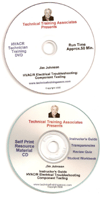Motor Data
Accurate data on the motor(s) that operate the equipment is critical. A minimum standard should be inclusion of a data sheet for each motor listing all of the basic parameters that appear on the motor nameplate such as manufacturer, type, frame, horsepower, bearing part numbers, etc. Nameplates on installed motors often become worn, damaged, dirty, or inaccessible and the presence of this information in the manual is invaluable.Larger motors and motors in special applications such as high-inertia load or plugging duty have additional performance parameters that should be included in the data sheet. These may include efficiency and power factor, minimum time between starts, maximum stall time, acceleration time of the motor and load, minimum terminal voltage during starting, and many others.
Much of this information was used by the electrical engineer during design to select fuse or circuit breaker ratings, determine starting method, and size the electrical system, and may be needed to troubleshoot problems within the motor controller or the facility electrical system.
Schematic and Wiring Diagrams
Following motor data, the most important electrical item is complete and accurate schematic and wiring diagrams. Schematics show the electrical logic of the power and control circuits and are used to identify the cause of failure.Wiring diagrams show the physical connections of the wiring between components and terminal boards. For simple systems, these may be combined into a single diagram in which wire and terminal numbers are shown on the schematic diagram.
Electrical diagrams should be specific for the model of equipment and the options or accessories furnished. Universal diagrams that include information for multiple models and for all possible options increase the amount of time required for troubleshooting. All wire, terminal, and component labels on the drawing must correspond to labels provided on the equipment. A legend or bill-of-material should be provided when acronyms or abbreviations are used. Field wiring should be discriminated from factory wiring, typically by dashes and solid lines, and all field wiring connections should be clearly identified.
Ensure that schematic and wiring diagrams are completely legible. The format of most O&M manual submittals is bound 8 1/2- by 11-in. pages. Reduction of large drawings to this size or even folded 11- by 17-in. size often results in text and details that are too small to read; the original drawing size is preferred.


